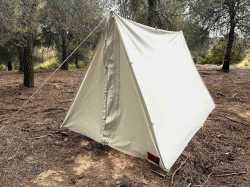>>2798158>information on camping gear of the past and how it was made?How far back are we talking? Military or civilian?
Peak tradgear was the 1920s, Germany. At the time, (good) shelters were made from "parachute silk", which is long-fibre cotton. That stuff has a weight comparable to modern synthetics, and sufficient strength to withstand a storm. Downside is that it's expensive to make (as you have to separate the fibres by lenght and end up with the majority of your cotton harvest in the trash), and afaik, nobody makes it anymore. That stuff is heavily waterresistant on its own, but if you need it to be completely waterproof, you'd use a polymerizing oil (linseed, normally) with lots of thinner (turpentine, for ex) to coat it. The oil hardens within the fibres and makes them hydrophobic while barely adding o the weight.
>bootsLeather boots, heavily waxed, with double socks instead of padding in the boots.
>warm clotheswool (winter) and linen (summer) for your base layers, wool felt (loden) or oilskin (cotton w/ linseed oil) for sell layers. Those, you can still get from traditional hunting stores, but quality is a bit lower because of mechanical processing of the wool and cotton, so they normally either have some synthetics added in, or are a bit heavier.
>backpack (yeah, I know you didn't ask)wooden frames, cotton bags, and a fur flap to keep out most of the rain
>sleepingsheep fur on the ground, wool blanket on top of you, and keep a fire going if it's really cold.
>>2798163>That tent in the picrel probably weighs about 25 pounds with the poles and pegsDoubt it. I have two tents like that (one homemade for larp, one German milsurp) and they're both below 10kg / 20pounds. And that's already with modern trash cotton. My grandfathers tent (made in the 1930s) was closer to 5 kg.

